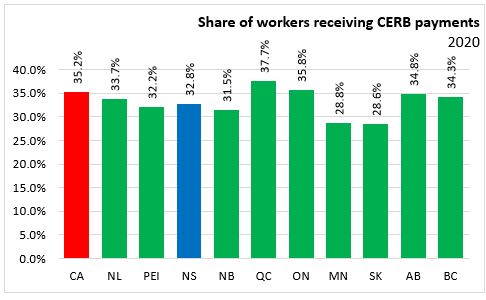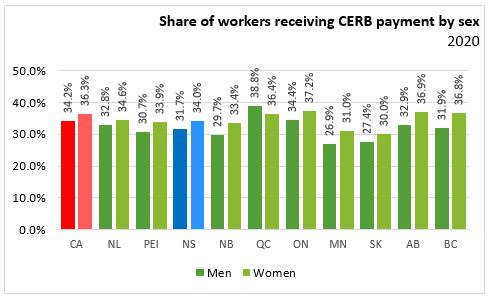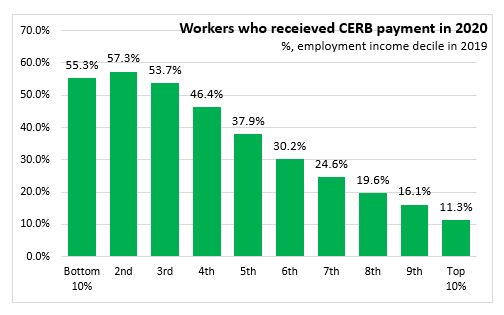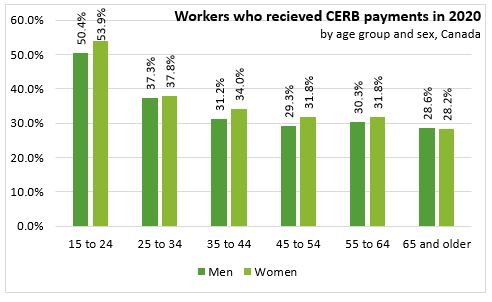The Economics and Statistics Division maintains archives of previous publications for accountability purposes, but makes no updates to keep these documents current with the latest data revisions from Statistics Canada. As a result, information in older documents may not be accurate. Please exercise caution when referring to older documents. For the latest information and historical data, please contact the individual listed to the right.
<--- Return to Archive
For additional information relating to this article, please contact:
June 02, 2021STUDY: WORKERS RECEIVING PAYMENTS FROM THE CANADA EMERGENCY RESPONSE BENEFIT PROGRAM, 2020 Statistics Canada released a new study “Workers receiving payments from the Canada Emergency Response Benefit (CERB) program in 2020” today which provides a demographic and labour market profile of those Canadians who received CERB from March to September 2020. The study focuses on the analysis of workers who had significant earnings in the year prior to the onset of COVID-19, i.e. who earned at least $5,000 in 2019.
At the onset of the COVID-19 pandemic, the Government of Canada implemented several programs that provide financial support to students, households, Canadian workers and businesses affected by the pandemic.
The Canada Emergency Response Benefit (CERB) was one of these programs and provided financial support to employees and self-employed Canadians who were directly affected by COVID-19.
The CERB was available for individuals residing in Canada; who were at least 15 years old; who had stopped working or had been working reduced hours due to COVID-19; who did not expect to earn over $1,000 in employment or self-employment income for at least 14 days in a row during a four-week period; who had employment or self-employment income of at least $5,000 in 2019 or in the 12 months prior to the date of their application; and who had not quit their job voluntarily.
Applicants received $2,000 for an initial four-week period and could reapply for additional periods, eventually extending to 28 weeks, for a maximum benefit of $14,000. The program covered the period from March 15 to September 26, 2020.
Among all Canadian workers who earned at least $5,000 in 2019, 35.2% received CERB payments for the period between March 15 and September 26, 2020. The provinces with tighter and longer lockdowns reported the highest proportions of workers receiving CERB. Quebec (37.7%) and Ontario (35.8%) reported the highest share of workers receiving CERB benefits while Saskatchewan and Manitoba reported the lowest share.
32.8% of workers in Nova Scotia who earned at least $5,000 in 2019 reported benefiting from CERB payments in 2020. Among the Atlantic provinces, the percentage of workers receiving CERB varied between 31.5% (in New Brunswick) and 33.7% (in Newfoundland and Labrador).

Out of the 28 weeks of the program, CERB recipients had on average 17.0 weeks of benefits. The average number of weeks of CERB payments for recipients was similar across the provinces ranging from 15.3 weeks in Prince Edward Island to 17.7 week in Ontario. On average Nova Scotia CERB recipients had payments for 17.2 weeks.

Women (36.3%) were more likely than men (34.2%) to received CERB as women accounted for higher share of workers in the sectors that were more affected by the lockdowns. According to the Labour Force Survey (LS) data over the same period, the total actual hours worked by women declined 16.3% from a year earlier compared with a 13.1% decline for men.

The share of workers receiving CERB payments was higher in industries that were adversely affected by the containment measures introduced in 2020. Sectors that rely on personal interactions were hit harder during the lockdown while industries such as finance and insurance or public administration which are more conducive to working from home were less likely to be impacted by lockdowns.
Accommodation and food services (66.6%) sector reported the highest percentage of workers receiving CERB payments in 2020, followed by arts, entertainment, and recreation (62.7%). The lowest share of workers was reported in utilities (7.0%), public administration (11.7%), or finance and insurance (12.3%) sectors.
Statistics Canada noted that several factors impacted the percentage of workers receiving CERB including the degree to which businesses utilized other support programs such as the Canada Emergency Wage Subsidy (CEWS) program. The CEWS covered part of employees’ wages for employers who had experienced a drop in revenue during the COVID-19 pandemic.
In line with the employment patterns seen in the LFS data, workers with lower annual earnings were more likely to receive CERB payments in 2020. More than half (55.3%) of workers who were in the bottom 10% of the employment income distribution received CERB payments in 2020. Only 11.3% of workers in the top 10% of the 2019 employment income distribution received CERB payments in 2020.

Young workers accounted for a relatively high proportion of CERB recipients in 2020. Among workers aged 15 to 24 who earned at least $5,000 in 2019, 50.4% of males and 53.9% of women received CERB payments in 2020. Among workers in the 35 to 44 age group, 31.2% of men and 34.0% of women received CERB payments.

Workers who belong to population groups designated as visible minorities were more vulnerable to the economic and health repercussions of the COVID-19 pandemic than non-visible minorities. Among workers who earned at least $5,000 in 2019, 41.4% of those who belonged to population groups designated as visible minorities received CERB payments, compared with 32.0% of individuals who do not belong to these groups.
According to the Statistics Canada, West Asian (50.8%), Southeast Asian (48.3%) and Arab (45.4%) workers were the most likely to receive CERB payments from March to September 2020, followed by Korean (43.3%), Black (43.0%) and Latino (41.8%) workers.
Indigenous workers were more likely to receive CERB payments than non-Indigenous workers. First Nations (41.5%), Inuit (40.3%) and Métis (36.2%) workers who earned at least $5,000 in 2019 received CERB payments in 2020 compared to 33.9% of non-Indigenous people. The higher percentage of CERB recipients among Indigenous workers reflect, in part, their overrepresentation in jobs that provide relatively low annual earnings. According to the 2016 Census, the median employment income of Inuit ($20,984), First Nations ($23,345) and Métis ($31,423) was less than that of non-Indigenous people ($34,013).
Statistics Canada notes that additional analysis of CERB and of other emergency government support programs will be released in the coming months.
Source: Statistics Canada, Workers receiving payments from the Canada Emergency Response Benefit program in 2020
<--- Return to Archive